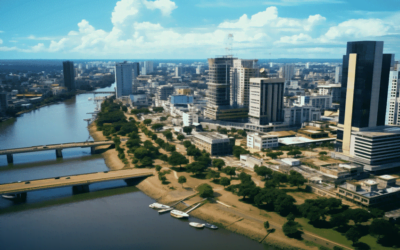Hey there, fellow drone enthusiast or inquisitive traveler of the digital skies! Are you ready to embark on a journey through the labyrinth of regulations and open airspace that is India’s drone laws? If you’re here, I reckon you’ve got some burning questions about the dos and don’ts of flying your trusty drone in this incredible country.
Well, you’re in the right place because I’ve been on a quest to decode the mysteries of India’s drone laws, and I’m here to share the treasure trove of insights I’ve unearthed.
You see, as a drone aficionado myself, I understand the struggle of navigating the legal skies. You want to soar above those mesmerizing landscapes and capture breathtaking shots, but you don’t want to inadvertently end up in a tailspin with the authorities.
I’ve been there, wondering if I’m doing the right thing or if I’m about to cross into no-fly territory. The good news is that I’ve done the legwork, sorting through the complexities of India’s drone regulations to bring you clarity and guidance.
So, if you’re itching to understand the ins and outs of India’s drone laws, you’ve come to the right place. In this article, I’m going to break it down for you step by step, offering you the key to unlock the skies legally.
I’ll provide insights into drone categories, registration requirements, altitude restrictions, the all-important Remote Pilot Certificate, and much more. By the time you’re done reading, you’ll be equipped with the knowledge you need to take to the Indian skies with confidence. Ready to get started? Well, my friend, read on, and let’s unravel the fascinating world of “India Drone Laws” together.
- Drone Categories and Registration
- General Rules for Flying Drones
- Remote Pilot Certificate (RPC)
- Drone Equipment and Mandatory Features
- Drone Insurance Requirements
- Foreign Operators and Drone Imports
- Drone Laws for Different Categories of Operators
- Final Thoughts on India Drone Laws
- Frequently Asked Questions on India Drone Laws
Drone Categories and Registration

Alright, let’s dive right into the nitty-gritty of drone categories and registration in India. The fascinating world of drones here is as diverse as the country itself.
You’ve got your Nano, Micro, Small, Medium, and Large drones. Each category comes with its own set of rules and regulations, so let’s unpack them one by one.
The Drone Categories – Nano to Large
In India, drones come in all shapes and sizes, much like our rich and varied culture. Here’s the scoop on the categories:
First up, the Nano drones, weighing less than 250 grams. These little fellas are like the pocket rockets of the drone world. No permits are needed unless you want to take them up to more than 50 feet above the ground level.
Next, we have Microdrones, ranging from 250 grams to 2 kilograms. No permits are needed for non-commercial use, but if you plan to take them soaring in controlled airspaces like airports or sensitive facilities, be prepared to ask for permission.
Small drones weigh more than 2 kilograms but less than or equal to 25 kilograms. If you’ve got one of these, you’re going to need a registration.
In the Medium category, you’re looking at drones weighing more than 25 kilograms but less than or equal to 150 kilograms. These are substantial pieces of technology, and they require registration too.
Finally, we have the Large drones, those weighing more than 150 kilograms. You guessed it; these birds need to be registered as well. The sky’s the limit, but only if you’ve got your paperwork in order!
Mandatory Registration
Now, let’s talk about the ‘R’ word – Registration. In India, we like to keep track of our drones, so most categories, except the Nano drones, require registration. It’s like giving your drone its own identity card.
You’ll need to get a Unique Identification Number (UIN) for your drone, and it’s as essential as your own ID card when you’re out and about.
The registration process isn’t overly complicated, but it’s necessary to ensure safe and responsible flying. So, don’t skip this step; it’s part of the game.
The Unique Identification Number (UIN)
Alright, I know what you’re thinking – what’s this UIN business? The Unique Identification Number (UIN) is like your drone’s personal passport. It distinguishes your drone from the rest of the flock and makes sure everyone knows it’s flying legally.
When you register your drone, you’ll get this special UIN. It’s a combination of numbers and letters, and it’s unique to your drone. Keep it safe; it’s your drone’s identity in the eyes of the law.
Existing Drones – Pre-November 30, 2021
Now, what if you already own a drone that was either made in India or imported before November 30, 2021? Well, the good news is you’re not left out in the cold. You can still register your trusty drone.
You have a 31-day window from the aforementioned date to apply for registration and obtain your UIN. Just make sure you meet the criteria and provide all the required information. It’s all about keeping up with the times, even in the drone world.
So, there you have it – a snapshot of how drones are categorized and registered in India. Remember, it’s all about keeping the skies safe and the drone community buzzing with excitement. Keep reading to explore more about India’s drone laws.
Also Read: Drone Regulations in Iceland 2024
General Rules for Flying Drones

Now, let’s fasten our seatbelts and get ready to explore the general rules that keep the Indian skies safe and orderly for drone enthusiasts like us. These are the guiding principles, and understanding them is essential for a hassle-free flight experience.
Visual Line of Sight Requirements
When you’re up there with your drone, you need to keep an eagle eye on it – quite literally. The rule in India is that drone pilots must maintain a direct visual line of sight at all times while flying.
It’s like having your trusty sidekick with you, ensuring you’re in control of your drone’s every move. So, no binoculars, no flying around corners; keep that visual connection strong.
Maximum Flight Altitude and Nano Drone Restrictions
We all love to reach for the skies, but in India, there’s a limit to how high you can go. Drones cannot be flown more than 400 feet vertically, giving ample space for everyone, both ground and air.
However, for our Nano drones weighing less than 250 grams, even the sky has its limits – they can’t soar beyond 50 feet above the ground level.
No-Fly Zones and Prohibited Areas
Now, here’s where it gets a bit tricky. Just like some places are off-limits on the ground, there are areas in the sky where your drone can’t wander.
These are the “No-Fly Zones,” and they include locations near airports, international borders, Vijay Chowk in Delhi, the State Secretariat Complex in State Capitals, strategic locations, and military installations. It’s all about ensuring the safety and security of these areas, so no drone adventures there.
Permission for Controlled Airspace
If you’ve got your sights set on flying your drone in controlled airspace, there’s a process to follow. You’ll need to file a flight plan and obtain a unique Air Defense Clearance (ADC)/Flight Information Center (FIC) number. It’s all about keeping everyone in the know and avoiding any unexpected surprises up there.
“No Permission, No Takeoff” (NPNT) Policy
Now, here’s something that keeps the drone community in India ticking smoothly – the “No Permission, No Takeoff” policy, or NPNT for short.
This means that before every single flight, drone pilots are required to request permission via a mobile app. The Digital Sky Platform processes the request and either grants or rejects it. So, if you want to take off and soar into the azure skies, you better make sure you’ve got that digital thumbs-up.
And there you have it – the essential general rules for flying drones in India. These guidelines ensure that we can enjoy the thrill of aerial adventures while keeping safety and security as top priorities. Ready for more insights? Keep reading to explore the world of “India Drone Laws.”
Also Read: Drone Regulation in Hungary 2024
Remote Pilot Certificate (RPC)

Welcome to the fascinating world of the Remote Pilot Certificate, my fellow drone enthusiasts! In India, this little piece of paper holds the key to some epic high-flying adventures. Let’s unravel the mysteries of the RPC and understand why it’s crucial for our drone journeys.
The Remote Pilot Certificate – Your License to Fly
The Remote Pilot Certificate, or RPC for short, is like your golden ticket to the skies. It’s the official document that certifies you as a pilot of remote aircraft systems (drones). With this in your pocket, you’re legally authorized to take your drone out for a spin, be it for leisure or commerce.
Who’s Eligible?
Now, who can get their hands on this coveted certificate? Well, you need to be at least 18 years old but not more than 65. Age is just a number, but this range keeps things safe and sound. You also need to have passed your tenth-grade examination or an equivalent from a recognized board. So, if you’ve got your basics covered, you’re on the right path.
Training and Testing
You can’t just waltz in and grab an RPC; you need to earn it. That means completing the training specified by the Director-General and passing the tests conducted by authorized remote pilot training organizations. It’s like getting your wings – you need to prove you know how to use them safely.
Duration and Renewal
Once you’ve got that shiny RPC in your possession, it’s valid for ten years unless suspended or canceled. But there’s a catch – you need to renew it. The Director-General can extend the certificate for specified periods, up to a maximum of ten years, as long as you stay in the loop with refresher courses. It’s all about keeping our skills sharp and our flights safe.
And there you have it, the lowdown on the Remote Pilot Certificate. It’s not just a piece of paper; it’s your license to explore the skies safely and responsibly. So, if you’re planning to fly high in India, you better get acquainted with this essential certificate. Ready to learn more? Keep reading to dive deeper into the world of “India Drone Laws.”
Also Read: Drone Regulation in Honduras 2024
Drone Equipment and Mandatory Features

Alright, buckle up, folks. We’re about to dive into the techy side of India’s drone laws. Here’s the deal – in India, we’ve got some mandatory features for our drones. Let’s explore what makes our drones legal and safe for the skies.
Must-Have Features
When you’re taking your drone for a spin in India, there are specific features it must have. First up, it’s got to have GPS. This technology is like your drone’s map and compass, helping it stay on course and navigate with precision.
Next, we’ve got the Return-to-Home (RTH) feature. Imagine this as your drone’s built-in safety net. If things go haywire or it loses signal, RTH ensures it makes a beeline back to you, its trusty pilot.
Then there’s the anti-collision light, which is like the headlights on your car. It ensures that your drone is visible, even in the dark, preventing unexpected mid-air bumps.
Last but not least, there’s the ID plate. It’s like your drone’s license plate, clearly showing its unique identification number (UIN). This helps authorities keep track of registered drones and maintain order in the sky.
RF ID and SIM/No Permission No Takeoff (NPNT)
Now, here’s something cool – India’s got a unique system called “No Permission, No Takeoff” or NPNT. This is all about getting the green light before your drone even leaves the ground.
Before every flight, you need to request permission through a mobile app, which is part of the Digital Sky Platform. If the authorities grant permission, you’re good to go. But if not, your drone won’t take off. It’s like a digital bouncer for the skies, ensuring everyone’s safety and security.
So, when you’re prepping your drone for an adventure in India, make sure it’s equipped with these mandatory features. They’re not just for compliance; they’re for ensuring a safe and enjoyable flight for everyone in the sky and on the ground. Ready for more insights? Keep reading to explore the world of “India Drone Laws.”
Also Read: Drone Regulation in Haiti 2024
Drone Insurance Requirements

Alright, let’s talk insurance – the safety net that keeps our drone adventures worry-free. In India, drone operators have certain insurance obligations to make sure they’re covered in case the unexpected happens. So, what’s the deal with drone insurance in this part of the world?
Insurance Obligations for Drone Operators
When you’re flying a drone in India, it’s not just about rules and regulations – there’s a layer of protection involved. Drone operators are required to have insurance, just like you would for your car or home.
This insurance covers third-party risks and ensures that if your drone causes damage to life or property, there’s financial support in place to make things right. It’s a responsible move that safeguards everyone involved.
Exceptions for Nano Drones
Now, here’s an interesting tidbit. For our trusty Nano drones, those little flyers weighing less than 250 grams, there’s a bit of good news.
They can operate without the burden of third-party insurance. It’s like the government acknowledging that these tiny drones aren’t likely to cause much harm. But remember, it’s only the Nano drones that catch this break; all other categories need to be insured.
So, whether you’re cruising the skies with a sleek Nano drone or a beefier model, insurance is your security blanket. It’s all part of being a responsible and safety-conscious drone pilot. Ready for more insights? Keep reading to explore the world of “India Drone Laws.
Also Read: Drone Regulations in Guyana 2024
Foreign Operators and Drone Imports

Alright, let’s talk about the folks from other lands who are eager to explore the Indian skies with their drones. Foreign operators, listen up – India’s got some rules and exceptions in store for you.
Regulations for Foreign Operators
For our friends from abroad, there’s a bit of a restriction when it comes to flying drones in India. As of now, foreign operators are not allowed to take their drones for a spin in our airspace. But don’t be disheartened; there’s a workaround.
If you’re here for commercial purposes, you can lease your drone to an Indian entity. They’ll take it from there, ensuring you comply with India’s drone regulations. So, while the skies might be open, you’ll need a helping hand to navigate them.
Importing Foreign Drones
Now, let’s talk about importing foreign drones. India has placed a ban on the import of foreign drones but with a few exceptions. These exceptions are like the golden tickets in the world of drone imports.
They’re mainly for research purposes or government use. So, if you’re a researcher with a passion for drones or part of a government project, there’s a way for you to bring in foreign drones. But for the rest of us, it’s all about embracing the homegrown or locally-approved options.
So, foreign operators, if you’re eager to explore India’s skies, you’ve got to play by the rules. And for those limited exceptions, they come with their own set of hoops to jump through. It’s all about ensuring safe and responsible drone operations. Ready for more insights? Keep reading to explore the world of “India Drone Laws.”
Also Read: Drone Regulation in Guinea Bissau 2024
Drone Laws for Different Categories of Operators

It’s time to break down the drone laws for various categories of operators, so whether you’re a hobbyist or in it for business, India has got you covered.
Hobbyist Drone Laws
Now, let’s chat about the rules for drone hobbyists out there. If you’re flying a drone for non-commercial purposes, here’s what you need to know.
License and Registration Requirements
For hobbyist drone pilots in India, you’ll need to get yourself an India Remote Pilot Certificate (RPC). This certification is your ticket to the skies, allowing you to operate drones up to 2kg for non-commercial use.
You’re not off the hook when it comes to registration, though. Hobbyists still need to register their drones and ensure they’re in line with the law. Also, there’s no need to fuss about Drone Remote ID, but don’t forget the insurance. It’s all part of being a responsible hobbyist.
Drone Remote ID and Insurance Obligations:
Here’s the good news – as a hobbyist, you don’t need to worry about Drone Remote ID. It’s not a requirement for non-commercial drone pilots. However, insurance is still a must. It’s like having that extra layer of protection for your drone adventures. Accidents can happen, and insurance ensures you’re prepared.
Commercial Drone Laws
If you’re turning your drone passion into a profession, you’ll want to pay attention to the commercial drone laws in India.
License and Registration Requirements for Commercial Operators
When it’s business time with your drone, you’ll need to hold a commercial India drone pilot license. This RPC allows you to fly drones for business purposes. Alongside the license, you must register your drone. The rules ensure that commercial operators are held to a high standard of safety and responsibility.
Drone Remote ID and Insurance Obligations for Commercial Drone Operations
Unlike hobbyists, commercial drone operations do require Drone Remote ID. It’s all about accountability and transparency when you’re using drones for business. As for insurance, it’s essential. Commercial operations often involve higher risks, and insurance provides that financial safety net in case of any unfortunate incidents.
So, whether you’re flying for fun or for your business, India’s got a set of drone laws to keep things in check. Understanding these categories and their respective rules is key to safe and responsible drone operations. Ready for more insights? Keep reading to explore the world of “India Drone Laws.”
Drone Laws for Visitors to India
If you’re a drone enthusiast visiting India, there are some important regulations you need to be aware of. India welcomes tourists with open arms, but when it comes to flying drones, there are a few restrictions in place.
Restrictions on Foreign Visitor Drone Flights
Unfortunately, if you’re a foreign visitor, you won’t be able to take your drone to the Indian skies. The regulations currently prohibit drone flights by tourists. It’s essential to respect these rules to ensure a smooth and enjoyable visit.
Drone Registration, Remote ID, and Insurance Requirements for Tourists
As a tourist, drone registration isn’t applicable, and you don’t need to worry about Remote ID. However, insurance isn’t mandatory for tourist drone operations in India. While it’s not required, it’s still a wise move to consider insurance, especially if you’re carrying expensive equipment. Accidents can happen, and being prepared is always a good idea.
Drone Laws for Government Drone Operators
Government agencies in India also take to the skies with drones for various purposes. Here’s a look at the specific rules that apply to government drone operators.
Licensing and Registration Requirements for Government Drone Operators
Government drone operators need to adhere to a set of rules just like everyone else. This includes obtaining the necessary licenses and registering their drones. These measures help ensure accountability and safety in government drone operations.
Drone Remote ID and Insurance Obligations for Government Operations
Government operations are subject to the same Remote ID requirements as commercial operators.
This ensures transparency and accountability when government drones take flight. As for insurance, it’s not a requirement for government drone operations. The focus is on ensuring the proper use and accountability of these drones for various government activities.
So, whether you’re a tourist visiting India or part of a government agency, it’s crucial to be aware of the specific drone laws that pertain to your situation. These rules help maintain the safety and security of drone operations while also allowing for innovation and recreational drone flying. Let’s keep exploring the fascinating world of “India Drone Laws.”
Also Read: Drone Regulation in Guinea 2024
Final Thoughts on India Drone Laws

As we conclude our exploration of India’s drone laws, let’s take a moment to recap the key points you need to keep in mind when operating a drone in this diverse and beautiful country.
We’ve delved into the intricacies of India’s drone laws, understanding the different categories, registration requirements, remote pilot certification, equipment mandates, and insurance obligations.
We’ve also explored the restrictions on foreign visitors and the unique rules that apply to government drone operators. Remember, these rules are in place to ensure the safety and security of all those who take to the Indian skies with drones.
Whether you’re a hobbyist, a commercial operator, a tourist, or part of a government agency, knowing these regulations is essential to have a safe and enjoyable drone experience in India.
In the fast-evolving world of drone technology, staying informed about the latest regulations is vital. The Directorate General of Civil Aviation (DGCA) in India regularly updates its drone rules to keep up with the changing landscape.
To enjoy the skies to the fullest, it’s imperative that all drone enthusiasts, whether local or international, comply with these regulations. Safety and responsibility should always be at the forefront of our drone adventures.
While India provides a beautiful backdrop for aerial exploration, let’s remember to fly responsibly, respect the laws, and ensure that our drone experiences are both thrilling and safe.
By adhering to the rules, we can contribute to the positive growth of the drone community and ensure that this fascinating hobby continues to thrive in the Land of the Maharajas.
With this comprehensive guide to India’s drone laws, you’re now well-equipped to take your drone adventures to the next level. Fly high, fly safe, and embrace the beauty of India from a whole new perspective. Happy droning!
Frequently Asked Questions on India Drone Laws
Do I need a license to fly a drone in India?
Yes, in India, you generally need a license to operate a drone. The specifics depend on the category of your drone. Nano drones (weighing less than or equal to 250 grams) do not require a license. Microdrones (250 grams to 2 kilograms) can be used without a license for non-commercial purposes. However, for all other categories, including small, medium, and large drones, a Unique Identification Number (UIN) is mandatory, and a Remote Pilot Certificate (RPC) is needed for commercial operations.
Are there altitude restrictions for drone flights in India?
Yes, there are altitude restrictions in India. Drones cannot be flown higher than 400 feet above ground level (AGL). However, there’s a more specific restriction for nano drones, which should not be flown above 50 feet AGL.
What are the no-fly zones in India for drones?
In India, certain areas are designated as no-fly zones, and drone flights are prohibited in these locations. No-fly zones include areas near airports, international borders, Vijay Chowk in Delhi, State Secretariat Complex in State Capitals, strategic locations, and military installations. Flying in these areas is strictly prohibited and can lead to legal consequences.
How can I obtain permission to fly a drone in controlled airspace in India?
To fly a drone in controlled airspace in India, you need to obtain permission by filing a flight plan and obtaining a unique Air Defense Clearance (ADC) or Flight Information Center (FIC) number. This process is essential for ensuring that your drone operation doesn’t interfere with manned aircraft or other critical airspace activities.
Can tourists fly drones in India, and what are the requirements?
Foreign tourists are currently not allowed to fly drones in India. If you’re a tourist, you should refrain from operating drones in the country, as you would be subject to the same regulations and restrictions as local drone operators. It’s essential to be aware of the rules and respect the local laws during your visit to ensure a safe and enjoyable experience in India.













